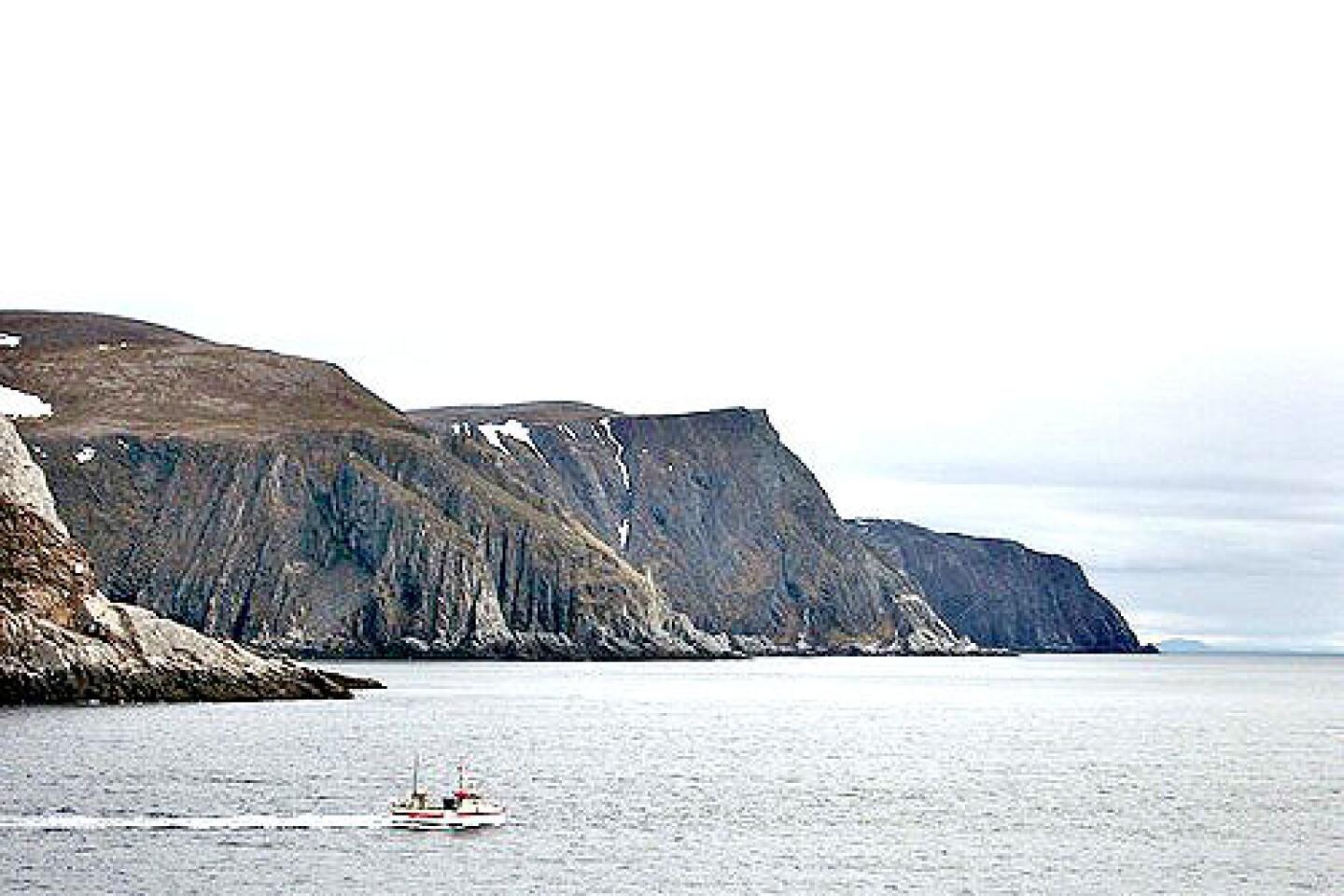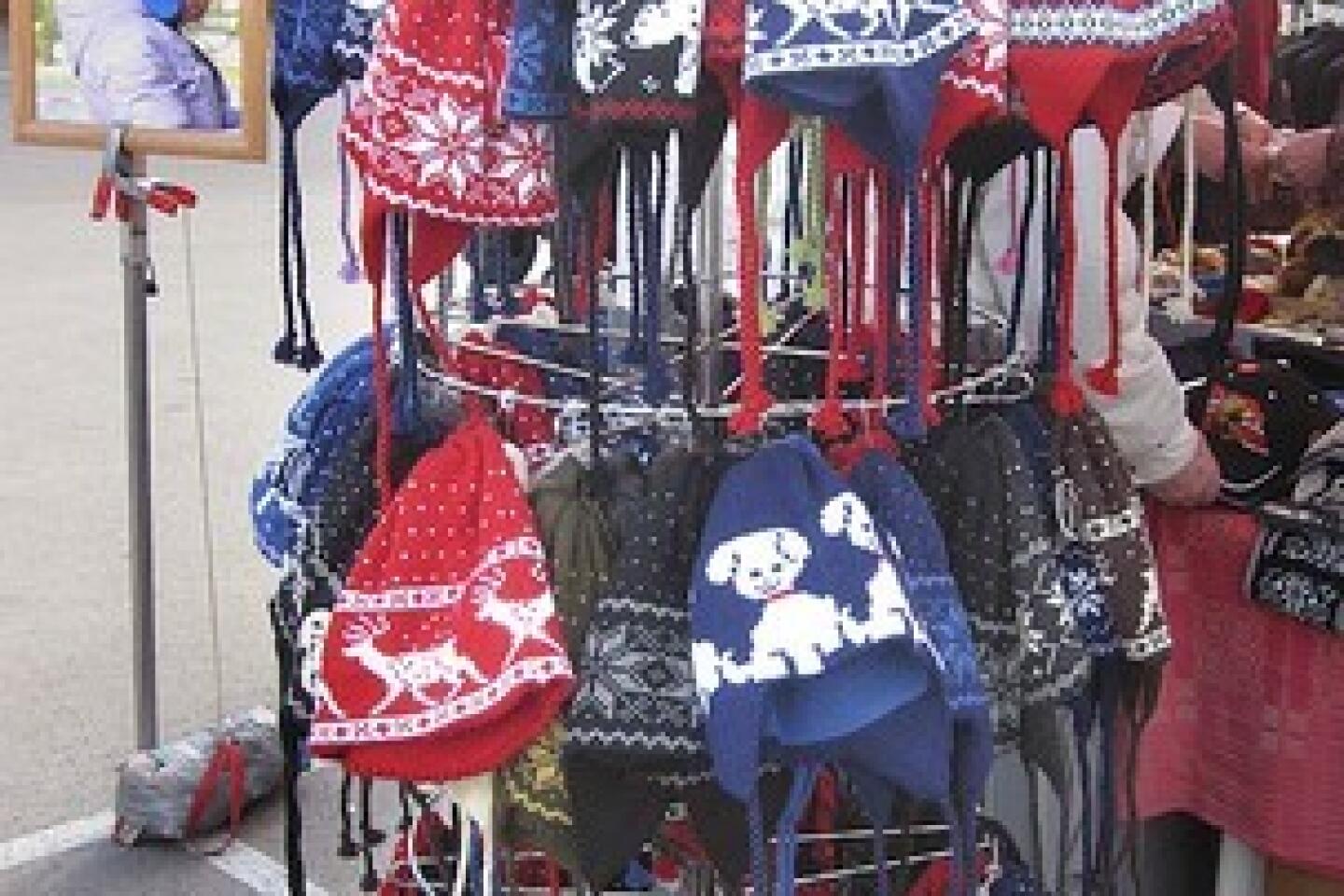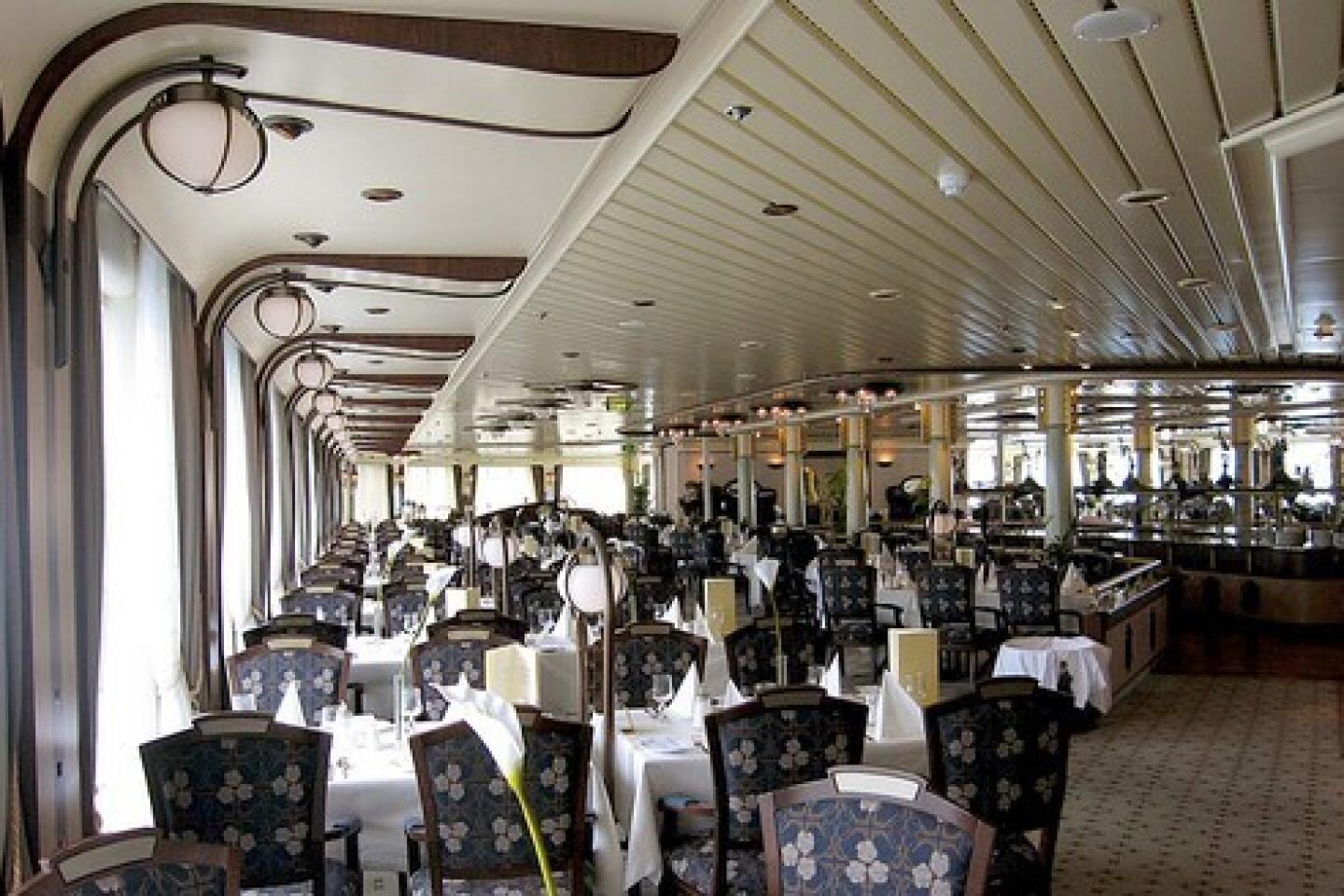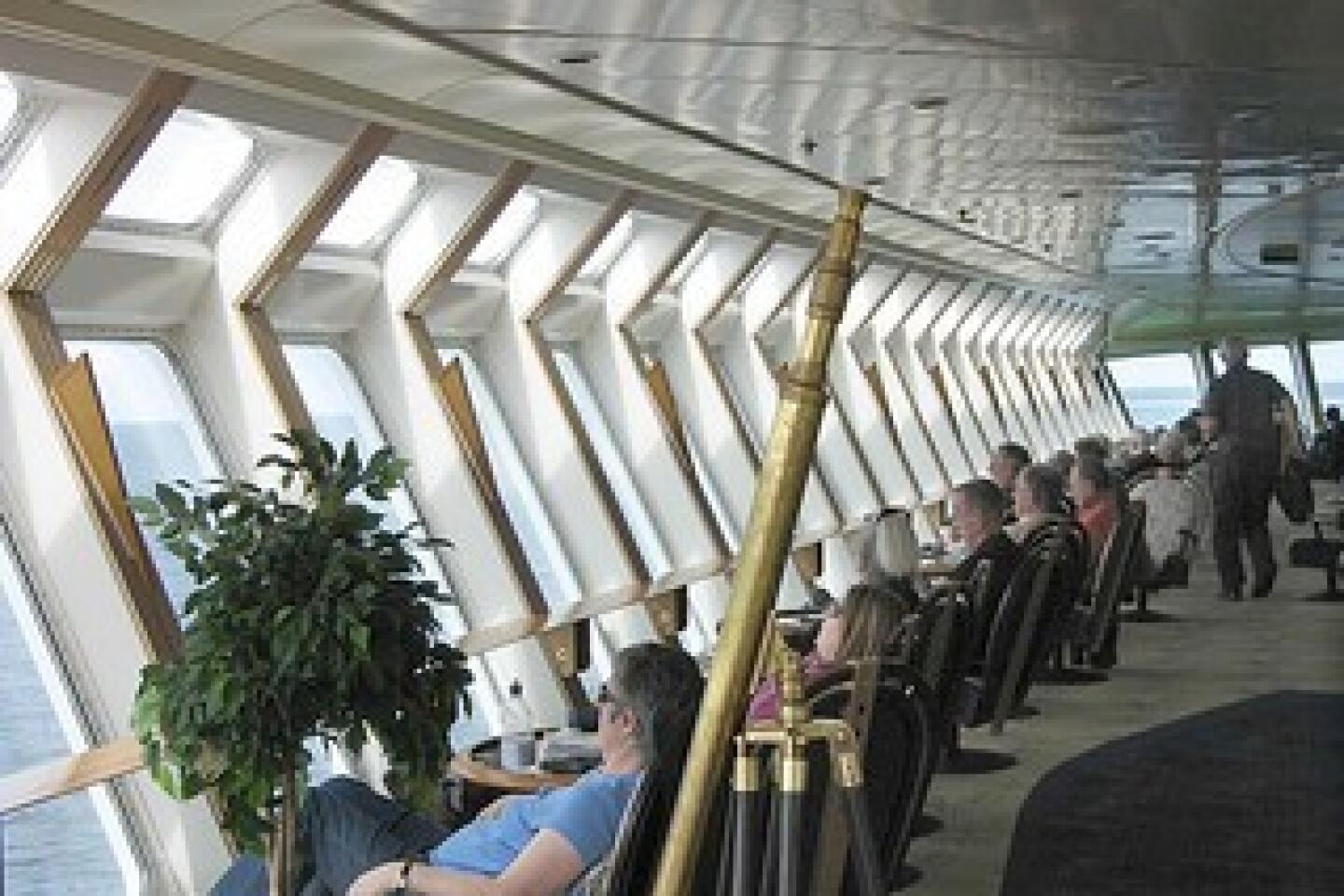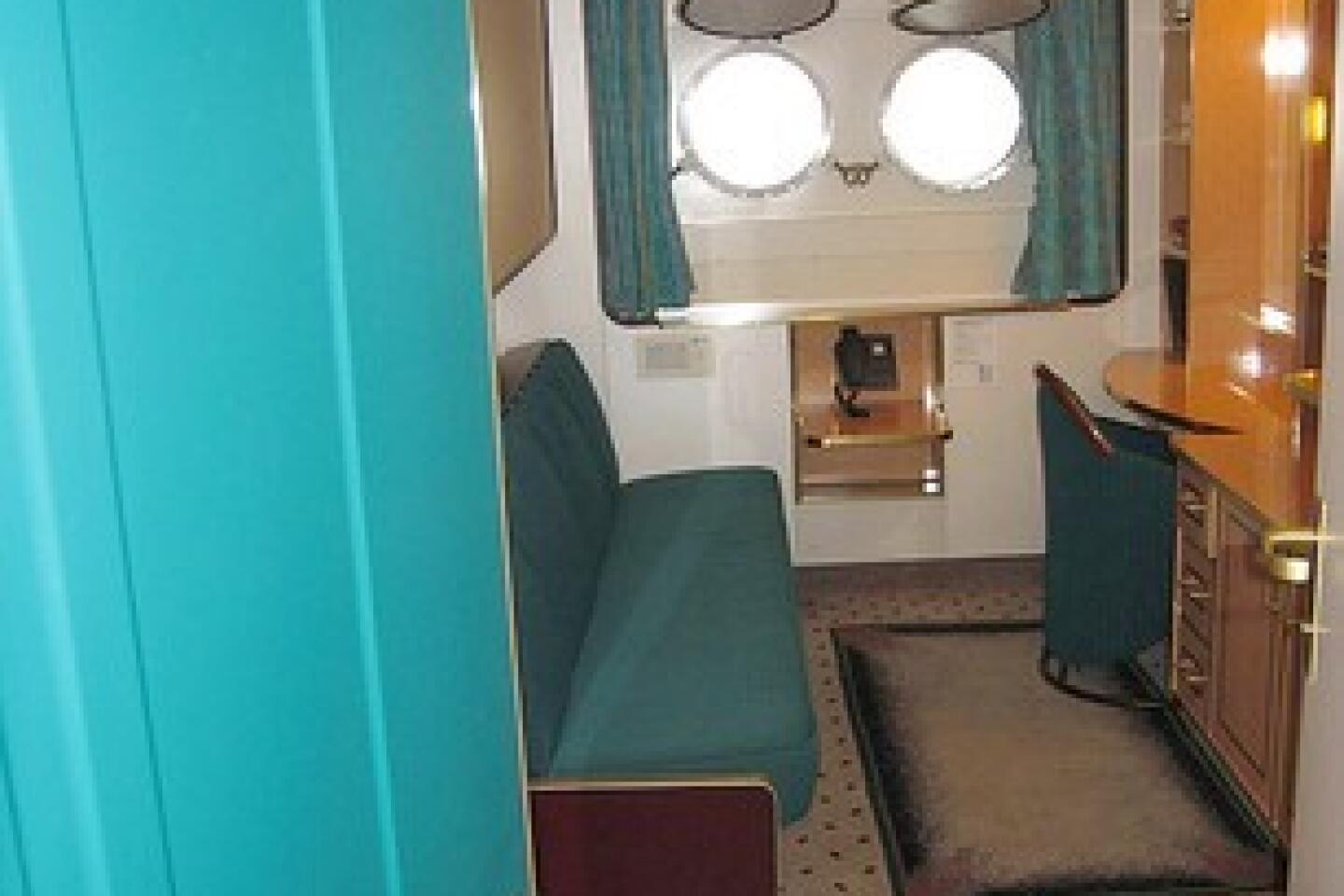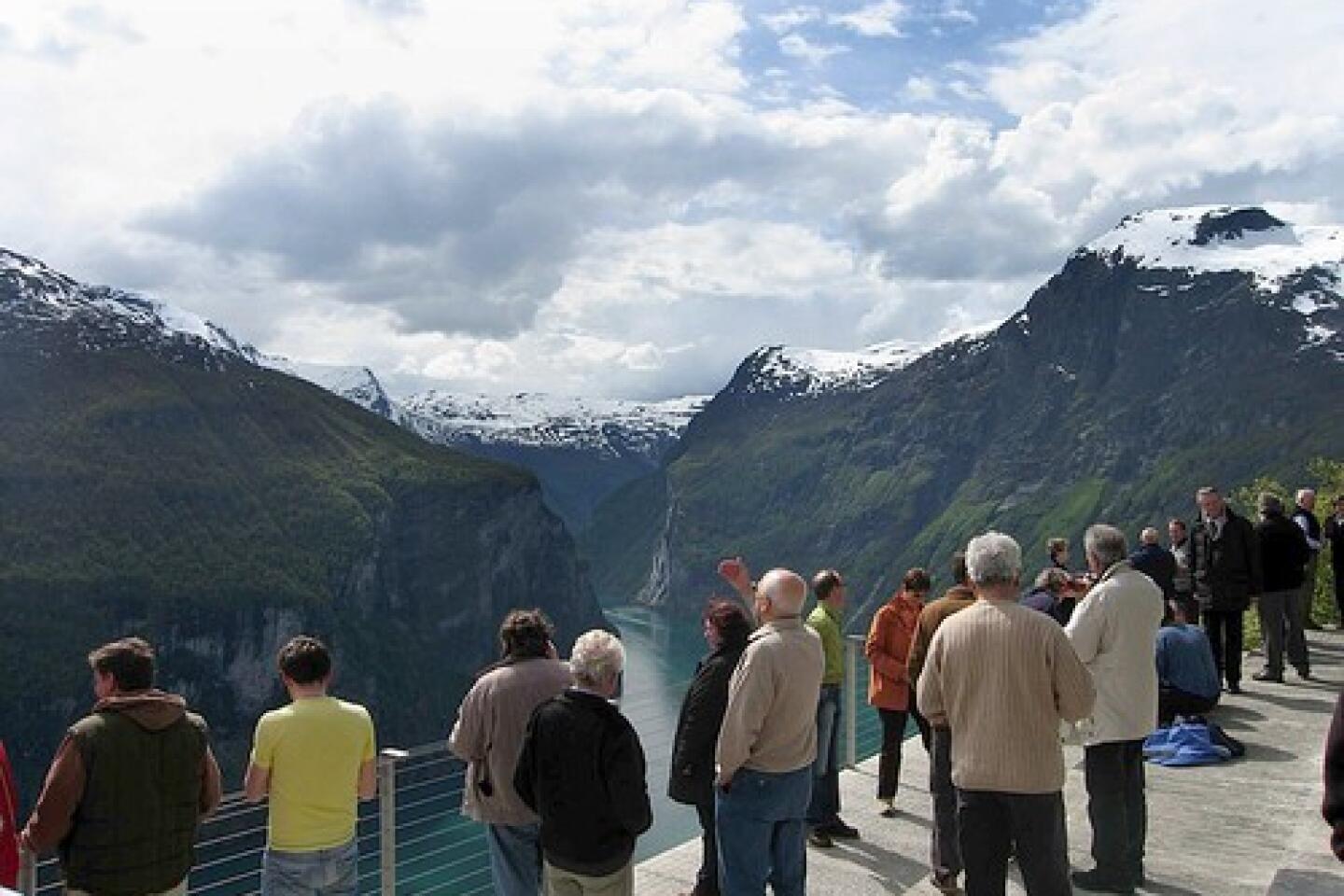A place of jagged beauty
SHAKING my shoulders to dislodge the ice cube that was slithering down my back, I stepped forward to claim the certificate verifying that I had crossed the Arctic Circle into the land of the midnight sun.
This was a rite of passage on Day 5 of a six-night Norwegian fiord cruise. “King Neptune,” a ship’s officer in a grotesque rubber mask, was doing the honors, aided and abetted by the captain. No ice, no certificate.
The Finnmarken is one of 13 ships of the Hurtigruten (coastal express) line that carries passengers and cargo between Bergen in southern Norway and Kirkenes in the north, near the Russian border. The company, Norwegian Coastal Voyage, bills this as “the world’s most beautiful voyage,” a superlative that’s hard to dispute.
The scenery along the journey, 1,438 miles each way, is so spectacular that it’s like trying to eat five desserts all at once — almost too much to take in. The deep green water of the fiords, carved into the snow-frosted mountains by melting glaciers. Waterfalls tumbling down sheer cliffs. A glacier up close. Lighthouses. Islands silhouetted against the sun.
It’s a great experience. For me, it began in late May when I flew to Amsterdam, connecting there with a Del Mar friend, Pat JaCoby, for the two-hour flight to Bergen, Norway’s second-largest city (with about 240,000 inhabitants) and embarkation point for the Finnmarken.
It’s about 13 hours’ flying time from Los Angeles, so we had booked an overnight in Bergen before sailing. We wished we’d factored in more time.
With just one day, we strolled the Bryggen wharf area with its brightly painted, gabled medieval houses, explored the lively fish market and took a three-hour bus tour that included Troldhaugen, the surprisingly modest lake-view home of Edvard Grieg, who composed some of his best-known works in his studio there. It looks much as it did at the time of his death in 1907, Steinway piano and all.
Our tour took in the Old Bergen Museum, an open-air attraction with 40 wooden houses from the 18th and 19th centuries, re-sited on squares and cobbled streets. At the old bakery, we were intrigued to learn that the walls were painted blue to keep away flies — a folk “remedy” still advocated in some parts of the world.
*
Floating gallery
WE made the move from land to sea well before the 8 p.m. sailing. As we boarded, I was surprised at how pretty the Finnmarken was. It’s not a cruise ship, and it doesn’t put on cruise-ship airs — no casino, no shopping mall, no room service, no musical revues. But it has some delightful public rooms, with cheerful splashes of primary color and nice nooks for reading.The Finnmarken, which entered service in 2002, is one of Hurtigruten’s three Millennium ships, the newest of its fleet. They carry on a tradition begun in 1893 when the line started hauling mail and goods to remote villages along the route.
The Art Nouveau-style Finnmarken is something of a floating art gallery, with paintings, weavings and sculptures by leading Norwegian artists.
I had booked the least expensive outside cabin available for single occupancy. Way, way forward, it had portholes — no big window, which was fine. It was on Deck 2, the lowest passenger deck (shared with cars), which wasn’t so fine. When we stopped at a port during the night, I was often jolted awake by the noise of the ship’s thrusters and the vibration of my bunk.
On the plus side, my cabin, although small, was well designed with plenty of storage. The bath with shower even had a heated floor. Cabin amenities included a telephone, a mini-fridge, a safe and a TV (CNN was usually accessible). Pricier cabins on upper decks have picture windows; balcony suites have a sitting area and hotel-style beds.
Passengers choose the 6:30 or 8:15 dinner seating in the restaurant, where expansive windows take advantage of views. (We chose the later seating.) Breakfast and lunch are buffets, and those are open seating. The food? On the high-calorie side, not really tuned to the American palate. The Brits (there were many) seemed to go for the sweet puddings, gelatin salads and canned fruit. There was plenty of smoked salmon and, for the Europeans, herring and more herring, beets and meats and cheeses for breakfast. Cereal, bacon and eggs were also offered.
The three-course dinners were uneven, with the fish usually better than the meats, which included a forgettable reindeer roast. As soon as we set down our dessert spoons and paper napkins, we were shooed out of the dining room so the crew could clean up; there was self-service coffee in the nearby Floybaren lounge.
The Finnmarken does not strive for elegance.
Passengers grumbled about the price of wine and bar drinks. A bottle of the house wine was about $40, or about $10 by the glass. Most wines by the bottle cost $48 to $65; bar drinks were $10 to $11.50.
On one shore excursion, I sat with an old sailor from the Isle of Man, who was lamenting that he had finished the whiskey he had brought on board. (This was allowed, but only for in-cabin consumption.) Unwilling to pay the price for a drink, he said, “I just shut me eyes and have a glass of water.”
The Finnmarken’s cabins, accommodating 643 passengers, were sold out. It also carries up to 350 deck passengers and day trippers. With a crew of 80, the ship seemed understaffed, with some people doing double duty. But most of the crew were helpful enough, if not effusive.
The ship has an outdoor pool for the few who dared brave the cold. There was a small exercise room and a hairdressing salon, but the lone hairdresser departed, as scheduled, at a port midway through the trip and was not replaced.
The entertainment? Scenery, scenery, scenery. In the evenings, a guitarist played, and the mostly mature crowd enjoyed dancing.
When it was light — as it was into the wee hours in the north — the place to be was the aptly named Panorama Lounge on Deck 8 in the comfy, highly coveted chairs facing the angled, floor-to-ceiling windows. From here, the scene was an ever-changing picture postcard.
The Finnmarken may not meet the expectations of those hoping for a cruise-ship experience, but the trip is great and it’s a good value. I was disappointed that the ports of call were largely commercial towns, not the idyllic villages of my fantasies, but that makes sense because this is a working ship. There are 34 stops on the way north, some while passengers sleep. (Those going round-trip, or making the six-day trip north to south, see by daylight the ports we made by night.)
Traveling south to north, the first day out is the best. The ship sailed into Geirangerfjord, which a Californian on board described as “like sailing through Yosemite Valley.” And it was, except that Yosemite has no grass-roofed farmhouses perched on mountainsides.
On the first of our optional excursions (which were as little as $25 for a city walking tour to as much as $140 for this fiord trip), we traveled by bus from the village of Geiranger (population 250), at the fiord’s mouth, up Eagle’s Way, a rim-hugging two lanes, to a lookout at 2,000 feet. There, we had the fiord at our feet, with the Seven Sisters waterfall putting on a show for us.
Geiranger, once a farming and fishing community, today lives mostly on tourism from thousands of ship passengers each year. Near the dock is a huge souvenir shop with the usual assortment of trolls, sweaters and Viking ships.
Climbing higher and higher through the jagged Sunnmore Alps, we passed herds of goats, farms with chalet-style houses and a village called Solvang. Water bubbled over rocks in a small creek that hugged the road.
We then boarded a car ferry that took us back across the fiord. From there, we drove through numerous villages.
In the village of Silner, our guide pointed out a red-roofed white farmhouse where playwright Henrik Ibsen once stayed.
Our destination was Alesund, once Viking country. Fire destroyed the town in 1904, and it was rebuilt by architects influenced by Art Nouveau (or Jugendstil). They incorporated design touches borrowed from the Vikings and the Stave churches into the many delightful buildings.
*
A stroll to the cathedral
THREE days out, steep, dramatic cliffs gave way to flatlands dotted with farms. As we sailed along, passing numerous islands, small fishing boats or a trawler sometimes accompanied us.At Trondheim, a town of 160,000 with the Nidelva River running through its picturesque center, Pat and I set out on foot for Nidaros Cathedral. The huge church has a lovely rose window inspired by the cathedral at Chartres, France. A Catholic church in medieval times, it has been Evangelist-Lutheran since the Reformation. Nowadays, services of other denominations, including Catholic, are held here, and Pope John Paul II visited in 1989. Just weeks ago, the Norwegian royal family came for a service and a concert marking the centennial of the coronation of King Haakon VII and Queen Maud, the last accession held in the cathedral.
Four days out, we boarded a small boat for an hour-plus ride to the formidable Svartisen glacier, Norway’s second-largest. It covers 230 square miles and is 1,900 feet deep at its thickest point. It was about 48 degrees and windy, and our boat guide, surveying her shivering charges, joked: “Don’t jump in, please. It’s not yet bathing season.”
Our view of the glacier was from across a very green lake at the sweet little Svartis Pavilion, where we were served coffee and cakes. I bought a book that told about the formation of the glacier 2,500 years ago as a result of a snowdrift that didn’t melt and became compressed into ice. (Until then, the area had had no glacier since the Ice Age.)
It was drizzling as we reboarded our bus for a 90-mile drive along a two-lane coastal highway carved out of the mountains. We passed through tunnel after tunnel, one almost five miles long. Our guide, Anne Katherine, regaled us with troll stories; a rock outcropping wasn’t a rock outcropping at all but the fingers turned to stone of a troll that became stuck there after coming home late one night and being locked out of his house.
Soon we were stopping at Saltstraumen, where the ocean tide entering the fiord creates deep, wide, dangerous whirls, moving at speeds up to 23 mph and producing the world’s strongest tidal current.
In contrast to the natural wonders, industrial Bodo was on our list of stops. It was bombed by the Germans, who occupied Norway in April 1940. The Germans and the Allies both coveted neutral Norway, strategically located with its long Atlantic coastline. German occupation lasted five years.
Way up north, the sun was still shining as, around midnight, we sailed into narrow Trollfjord, an exercise that let Capt. Sten Magne Engen display his navigational skills. As we watched from Deck 8, he turned the ship around inside the fiord with inches to spare.
Among memorable sights along the route was Finnkirka (Finn church), a cathedral-like formation carved out of a cliff. Legend has it that it was the site of ancient sacrificial rites.
One of the less intriguing shore excursions was on Day 5 in Tromso, whose claims to fame include being the gateway to the Arctic (it’s 200 miles inside the Arctic Circle) and site of the world’s northernmost Burger King.
I thought Tromso’s Polaria, an interactive center showcasing polar research, was ho-hum, with an overly long trained-seal show. But I did love the absolutely dizzying Arctic wilderness film on a wraparound screen. We zoomed with the camera through canyons of ice and met walruses and other creatures up close. I also enjoyed the city’s contemporary Arctic Cathedral, with its steeply pitched roof and stunning triangular stained-glass mosaic depicting the second coming of Christ. Its crystal chandeliers sparkle with icicle-like prisms.
On the last day of our voyage, we docked at the town of Honnigsvag, where Pat and I chose to take the bird safari.
The charter bus took us over a rocky, treeless landscape to the tiny fishing village of Gjesvaer. This is the land of the midnight sun. It’s also home to the Samis (or Lapps) who herd the reindeer we saw grazing.
At Gjesvaer, where cod was drying on wooden racks outside the brightly painted houses, we boarded a small boat for a choppy ride to the Gjesvaerstappan nature reserve.
The island is home to numerous species, including about 800,000 puffins, those fetching black-and-white seabirds with brightly colored beaks. They return each April 14 after spending the winter on the polar sea. The birds are plump, with short wings that they flap furiously, and were fun to watch in flight.
As our boat drew close to the island, we also spotted black cormorants, sea eagles, oystercatchers and razorbills, which looked just like miniature penguins sitting on the rocks.
In the morning, our journey would end at Kirkenes.
If I made the trip again, I’d board at Kirkenes and travel south, to see the picturesque Lofoten Islands by day. (The trade-off: Southbound voyagers miss Geirangerfjord.) And I’d pencil in several days to revisit the charming Bergen, to walk its crooked cobbled streets, browse its galleries showcasing Scandinavian design and — if I were lucky enough — take in a concert at Troldhaugen.
*
(INFOBOX BELOW)
North country
GETTING THERE:
From LAX, KLM and United offer connecting service (change of plane) to Bergen, Norway. Restricted round-trip fares begin at $980.
ABOUT THE TRIP:
The Finnmarken
makes the coastal voyage year-round. Cabin prices for double occupancy range from $1,149 to $4,173 per person for the six-night voyage, depending on the season. A single supplement is in effect from April through September, ranging from 25% to 75% of the double-occupancy fare, depending on season and cabin category.The ship will sail northbound from Bergen to Kirkenes on July 10 and 21; Aug. 1, 12 and 23; Sept. 3, 14 and 25; Oct. 6, 17 and 29; Nov. 9 and 20; and Dec. 1, 12 and 23. The southbound sailings, from Kirkenes to Bergen, will be July 5, 16 and 27; Aug. 7, 18 and 29; Sept. 9 and 20; Oct. 1, 12 and 23; Nov. 4, 15 and 26; and Dec. 7, 18 and 29.
TO LEARN MORE:
Norwegian Coastal Voyage, 405 Park Ave., New York, NY 10022 ; (212) 319-1300, https://www.norwegiancoastalvoyage.us .
— Beverly Beyette
Sign up for The Wild
We’ll help you find the best places to hike, bike and run, as well as the perfect silent spots for meditation and yoga.
You may occasionally receive promotional content from the Los Angeles Times.

